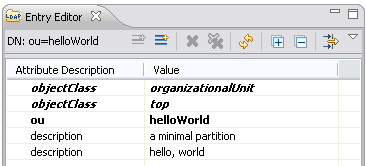Writing a simple custom partition for ApacheDS
On the mailing list, people ask regularly on how to write a custom partition. Please note that this is not an easy task. Nevertheless I try to give you a starting point with some simple examples.
If you simply plan to add another suffix to ApacheDS (besides example.com, for instance), it is not necessary to write any code. You can simply add some lines to the configuration.
The following is for those who plan to use another storage mechanism than the provided default.
What exactly is a partition?
Within ApacheDS, a partition is a physically distinct store for a subset of the entries contained within the server. A partition can be implemented using any storage mechanism or can even be backed in memory. The default storage mechanism for a partition is JDBM.
Implementing your own partition is basically implementing the Partition interface from the org.apache.directory.server.core.partition package.
Hello world. A minimal partition
Let's start with a minimal partition, the hello world. Minimal means here, that it is possible to add it to ApacheDS and see it with an LDAP browser. The partition ...
- correctly implements the Partition interface
- is pluggable in the server (embedded and declarative in the configuration)
- is visible for clients like ldapsearch or Apache Directory Studio
- contains one entry, which contains the famous "hello, world" message in an attribute value
- does not support any modification operations like delete, add etc.
- does not take account of filters in search requests, ...
The sources
Currently, the sources are checked in here
In order to build it, simply check it out and type "mvn install".
Implementing the class
Using the partition
Embedded mode
package org.apache.directory.samples.partition.hello;
import org.apache.directory.server.core.DefaultDirectoryService;
import org.apache.directory.server.core.DirectoryService;
import org.apache.directory.server.ldap.LdapService;
import org.apache.directory.server.protocol.shared.SocketAcceptor;
public class Main {
public static void main(String[] args) throws Exception {
DirectoryService directoryService;
SocketAcceptor socketAcceptor;
LdapService ldapService;
directoryService = new DefaultDirectoryService();
directoryService.setShutdownHookEnabled(true);
socketAcceptor = new SocketAcceptor(null);
ldapService = new LdapService();
ldapService.setSocketAcceptor(socketAcceptor);
ldapService.setDirectoryService(directoryService);
ldapService.setIpPort(10389);
HelloWorldPartition helloPartition = new HelloWorldPartition();
helloPartition.setSuffix("ou=helloWorld");
helloPartition.init(directoryService);
directoryService.addPartition(helloPartition);
directoryService.startup();
ldapService.start();
}
}
Adding it to a server.xml file
In order to use the partition in a standard installation of ApacheDS, simply add it to the server.xml configuration. Provide a "native" Spring bean like this.
<spring:beans xmlns:spring="http://xbean.apache.org/schemas/spring/1.0"
xmlns:s="http://www.springframework.org/schema/beans"
xmlns="http://apacheds.org/config/1.0">
...
<defaultDirectoryService ...>
...
<partitions>
...
<s:bean
id="helloPartition"
class="org.apache.directory.samples.partition.hello.HelloWorldPartition">
<s:property name="suffix" value="ou=helloWorld" />
</s:bean>
</partitions>
...
</defaultDirectoryService>
...
Note that the class HelloWorldPartition has to be in the class path of the server. Withgout, starting the server leads to a ClassNotFoundException. You can copy the jar file which results from the build to the lib directory and adjust the command line parameters in the apacheds.sh script.
verification
After adding the HelloWorldPartition to the directory service like above (embedded or via configuration in server.xml), you can browse it with an LDAP browser like the one from Apache Directory Studio. Here are some screen shots.
Of course using a command line tool works as well ...
$ ldapsearch -h localhost -p 10389 -D "uid=admin,ou=system" -w secret \\
-b "" -s base "(objectclass=*)" namingContexts
version: 1
dn:
namingContexts: ou=system
namingContexts: ou=helloWorld
namingContexts: ou=schema
$
$ ldapsearch -h localhost -p 10389 -D "uid=admin,ou=system" -w secret \\
-b "ou=helloWorld" -s base "(objectclass=*)"
version: 1
dn: ou=helloWorld
objectClass: organizationalUnit
objectClass: top
description: hello, world
description: a minimal partition
ou: helloWorld
$

